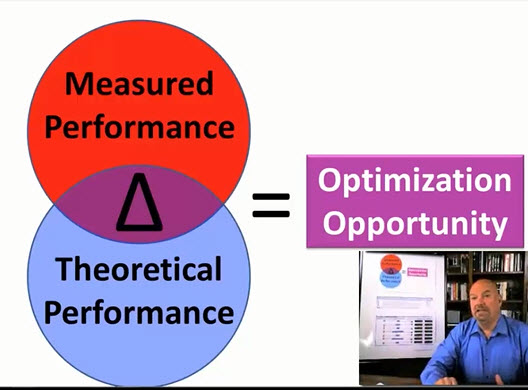Watch Bill Alderson’s video on Oracle performance optimization ROI justification based on detailed packet analysis findings. This video is for CIO’s to help justify portfolio spending on database improvements… a technical companion Video is posted showing the case study packet trace explaining the technical analysis to find optimization opportunities
Transcript for this Video
This session is on Oracle database management to optimize performance and yield a significant ROI. First of all, a quick review from your technologist session. You measure the performance, you measure or calculate the theoretical performance, and arrive at an optimization opportunity. That’s the delta.
What that looks like is a trace file where we look at SYN, SYNACK, Oracle Connect. The Oracle connects. It takes 73 milliseconds. That 73 milliseconds happens for each and every SQL query, and what we want to do is knock out and use, not an implicit logon to the database for each and every query, but one logon and then several secondary queries. That will allow us to knock out that 73 milliseconds entirely practicing Oracle performance optimization.
So here’s how you might justify this. First of all, you put together a spreadsheet of your measured performance and your theoretical performance, and you come up with your optimization opportunity. In this case, it’s 72 milliseconds. So what you do is you’ve got your number of users at your call center, your underwriters, your branches, your managers, and your report time generation. Now this can be different for different companies, of course. This is basically looking at a financial institution and a large number of transactions that people are doing at different labor rates and that sort of thing.
So we basically take the micro-transactions and we calculate that out to find out how long it’s taking. So if it’s taking an extra six seconds per transaction, and that’s because of this 72 millisecond logon, and we can knock that down to 72 milliseconds, then you can calculate out for this many users. I’ve just done some very simple equivalent person calculations. For instance, if you’ve got 3,000 people in the call center, you can probably drop 49 of those people just by this single optimization.
Now if you take into consideration all of the cost elements, you’d save $3 million in the first year of this optimization, just in the call center. So that’s probably a good enough justification right there. But you add them all up, and you’ve got $4 million. Now, if the optimization costs $325,000 to rearchitect and logon once to your database and then have multiple subsequent queries, instead of 86 queries and 86 logons, you would end up achieving a cost savings in the first year of $3.6 million. Now, if you have five years of useful life, that would be a $20 million savings. If you calculate out what your recoup rate is at $333,000 per month, it would take you one month to pay off the investment of $325,000 in rearchitecting this application in a very simple manner and save yourself $20 million over the next 5 years. Not a bad day’s work. Consider becoming a performance oracle!

